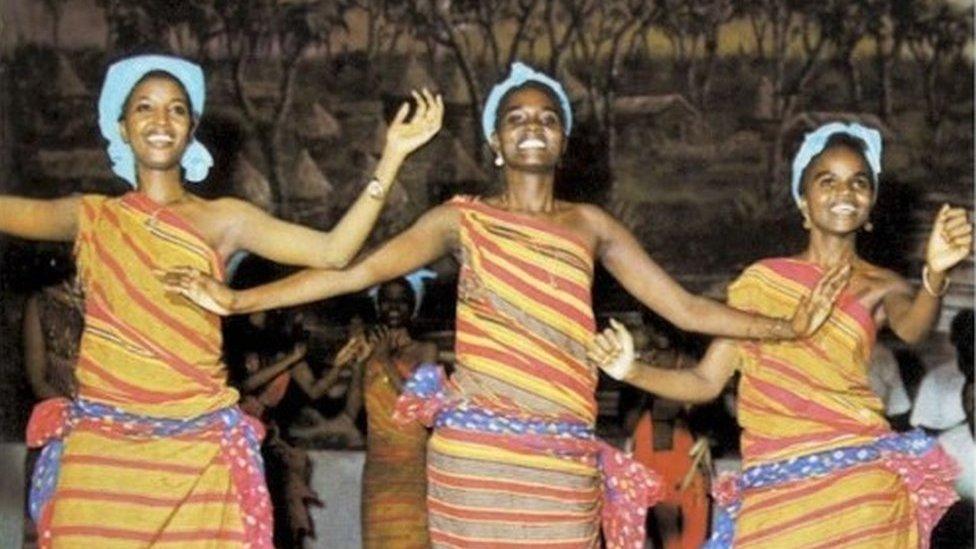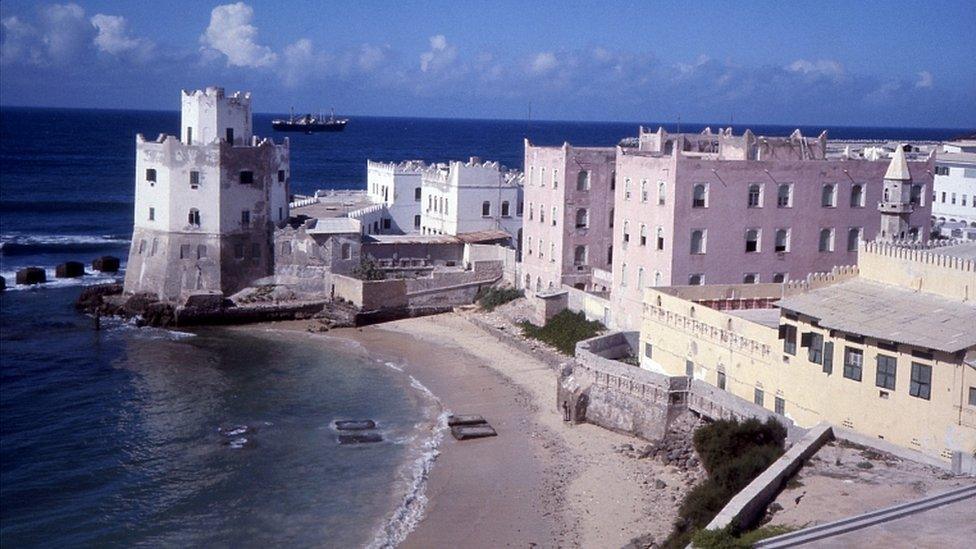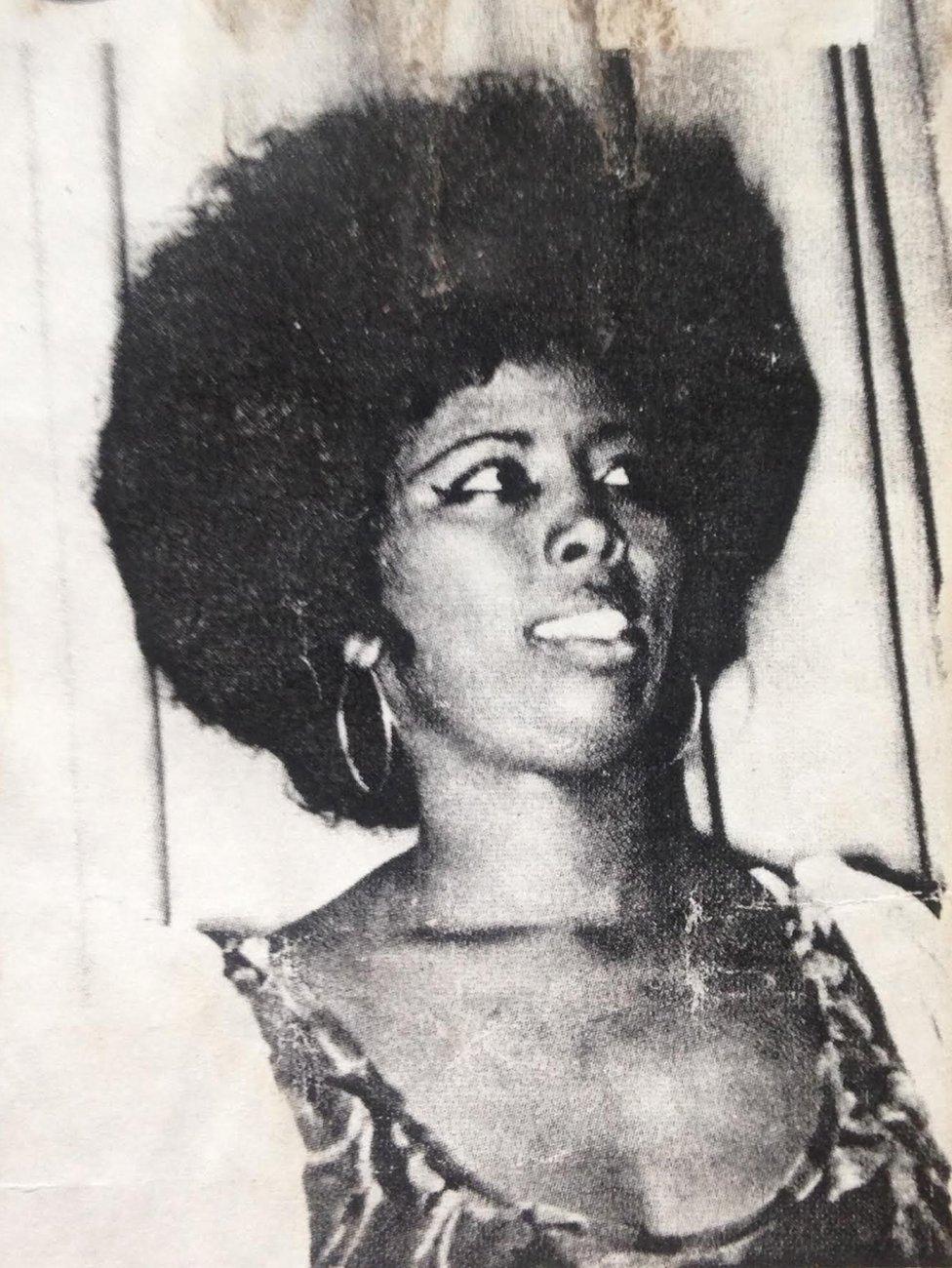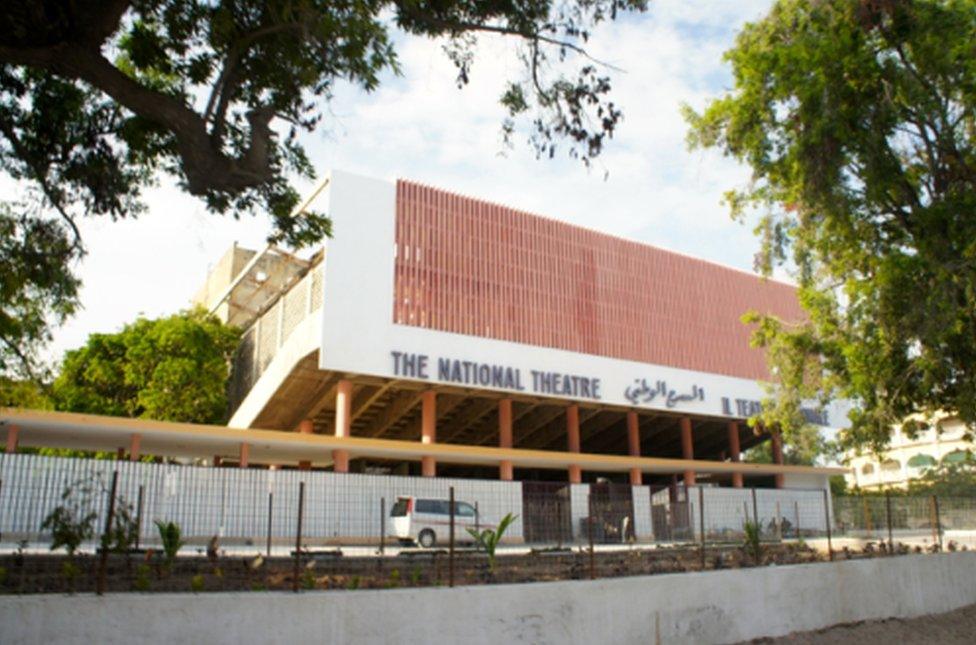Somalia's lost tapes revive musical memories
- Published

Members of Somali band, Waaberi, take to the stage in 1970s Mogadishu
The discovery of thousands of lost recordings from Somalia's golden era of music is a timely reminder of the country's remarkable hybrid sounds, writes BBC Somali's Yasmin Ahmed. A newly released compilation, Sweet As Broken Dates: Lost Somali Tapes from the Horn of Africa, features some of the recovered audio.
Over the last few decades, Somalia has become a symbol of poverty and anarchy.
But while recent Hollywood blockbusters Captain Philips and Black Hawk Down have depicted civil war and modern piracy in Somalia, people who lived in the capital, Mogadishu, in the early 1970s will tell you a very different story.
Whitewashed coral houses, cafes and restaurants with Moorish arches graced the streets of Mogadishu.
Men sported afros and flared trousers, while women dressed in their colourful baatis (a classic cotton dress) and diracs (loose-fitting dress) with their heads uncovered.
Evidence of centuries of cross-cultural trade and migrating nomadic tribes can be seen in the architecture, and this cultural influence also explains the remarkable hybrid sound of Somali music.
Now Somalis around the world can relive these rich memories of Mogadishu through an archive of more than 10,000 tapes which music producer Vik Sohonie was given access to by the Red Sea Cultural Foundation in Hargeisa, capital of the self-declared republic of Somaliland. Funk, rock, jazz and Bollywood influences feature in the rich and varied recordings.
'Golden age'
The tapes take us back to a time of relative economic and political stability in Somalia.
Although the country was under military rule, the arts - particularly music - flourished and the period became known as the golden age.

Bars and nightclubs were a part of everyday life in 1970s Mogadishu
Mogadishu was home to popular hotels Al-Uruba and Jazeera, where young fans would flock to the dancefloor to hear groups like Iftiin and Dur Dur perform.
Somalia's music industry was effectively nationalised under authoritarian leader General Siad Barre, who brought most industries under state control in the hopes of ridding the country of clan-based politics.
During this period, record companies could not release music to the market.

Mogadishu features a wide variety of architectural styles
The National Theatre was a revered forum where music groups produced remarkable music, but the performers became attractive propaganda tools for General Barre's message.
Theatre companies known as bands, notably Iftiin Band and Waaberi Band, expressed nationalism in their lyrics and style.
One song, the Waaberi Band's Oktoobar waa tee, waa tumaa? (What is October, which one is it?) became a hit after the Barre-led military junta came into power on 21 October 1969.
The song recounts various key Somali historical events which have taken place during that month.
Schoolchildren across the country recited the anthem, which was also performed on the streets by military marching bands and frequently played on state-run Radio Mogadishu:

Oktoobar waa tee? Waa tumaa?
What is October, what is it?
Waa taa yadii.
It is ours.
Hadii ay tahay teenii taariikh ma leedahay oo maxaa lagu tilmaamaa?
If it ours, does it have history and how is it marked?
Waxaa lagu tilmaamaa maalinti dhagax tuur Oktoobar.
It marks the "stone-throwing" 1949 October uprising.
Waxaa lagu tilmaamaa markaan caalan taagnay Oktoobar.
And October marks the month our flag was created.
Waxaa lagu tilmaamaa towraddeena dhalatay 21 Oktoobar
It marks the 21st of October, the day the revolution started.

"When I look back, I sometimes break into tears," says celebrated singer Maryan Mursal. "I'm welling up right now as I picture what Mogadishu was like in the 70s."
Before her successful solo career, Mursal won a nationwide talent competition called Tartanka heesaha hirgalay (The Singing Competition) and performed with the Waaberi Band.
"We had bars in Mogadishu and five nightclubs. We travelled from city to city and performed in hotels and bars. Those were the golden years."

Star singer Hibo Nuura performed pro-Barre songs in the 1970s but later spoke out against the regime
Mursal, like many other performers in bands like Waaberi band, Shareero and Dur Dur, fled Somalia after decades of war and now lives in the diaspora.
Dhaanto: The Somali reggae
"Dhaanto", an ancient Somali folk song and dance, was historically played without instruments, with hand-clapping and foot-stamping used as rhythmic accompaniment.
Nomadic tribes would take their camels into their ranch at night and venture out to compete with each other.
This folk style was enhanced throughout the 20th Century and again by the likes of the Sharero band and Khadija Qalanjo in the 1980s.
The Sharero band, featuring Faadumo Qaasim, perform Qays iyo Layla (Romeo and Juliet)
The new sounds bustles with an electrifying synthesis of different musical instruments, and shares rhythms and characteristics with reggae.
Somali musicians of that time debate whether dhaanto preceded reggae and dub.
"Over the years, different cultures and ancient traditions have influenced and shaped music,'' says Abdinasir Aideed, a bass player for dhaanto artist Danan Hargeysa.
"Dhaanto and reggae are very similar and share the same rhythm.''
A 'miraculous' era for women
This period was a time when society began to accept female artists, when the melodiousness of their voices was likened to the sweetness of dates.
In Mogadishu's prominent nightclubs, female artists attracted more followers and drew more crowds than their male counterparts.
"They used to call us all kinds of nicknames before the 1970s. Some women used to hide," 70s star singer Khadra Daahir told the BBC.
Khadra Daahir on Somalia's 'miraculous' 70s arts scene
"People said we were dead, lost and a disgrace to our people," she recalls.
But Daahir says that society's perception of women transformed within a decade.
"It was a miraculous era. During the 70s, people became open-minded, they got used to women singing, dancing and performing.
"They realised it's part of Somali culture and people started to admire us."
But Daahir was no stranger to unconventional careers. Before her success in music, she was an athlete and basketball player, competing in regional and national competitions.
Restoring the arts
After decades of trauma, Somalia is now going through a process of cultural and political healing.
Under a national recovery plan, the National Theatre is being rebuilt, having been destroyed during the conflict and a restoration of the arts is under way.

What Somalia's National Theatre used to look like
Funk, pop and reggae may not be musical genres that people associate with Somali music.
For Somalis today, the golden age is not the thing of the past but a symbol of hope for the future.
Sweet As Broken Dates: Lost Somali Tapes from the Horn of Africa is released on Ostinato Records, external.
Correction 22 February 2018: This story has been amended to remove an incorrectly captioned photo and clarify the evolution of dhaanto, following a complaint to the BBC's Executive Complaints Unit., external